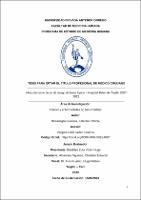Mostrar el registro sencillo del ítem
Infección como factor de riesgo de brote lúpico – Hospital Belén de Trujillo 2007- 2022
| dc.contributor.advisor | Vergara Celis, Javier Eduardo | |
| dc.contributor.author | Bocanegra Guevara, Katerine Patricia | |
| dc.creator | Bocanegra Guevara, Katerine Patricia | |
| dc.date.accessioned | 2023-05-23T13:14:11Z | |
| dc.date.available | 2023-05-23T13:14:11Z | |
| dc.date.issued | 2023 | |
| dc.identifier.uri | https://hdl.handle.net/20.500.12759/10703 | |
| dc.description.abstract | Determinar si la infección del tracto urinario es factor de riesgo para brote lúpico en pacientes atendidos en el Departamento de medicina del Hospital Belén de Trujillo 2007 – 2022. MATERIAL Y MÉTODOS: La presente investigación, es un estudio de casos y controles de 92 pacientes atendidos en el Departamento de Medicina Interna del Hospital Belén de Trujillo 2007 – 2022 que cumplieron con los criterios de selección, se dividieron en dos grupos: pacientes con diagnóstico de LES que desarrollaron brote lúpico y pacientes con diagnóstico de LES que no desarrollaron brote lúpico, evaluándose de esos grupos si tuvieron infecciones o no, en especial del tracto urinario. Se revisaron y obtuvo los datos solicitados según la ficha de recolección de datos de las historias clínicas. Para la extracción de datos se utilizó Microsoft Excel 2016, en el procesamientos de los datos y análisis estadístico se utilizó el programa estadístico IBM SPSS statistic 26. RESULTADOS: De los pacientes del estudio con brote lúpico la frecuencia de quienes desarrollaron infección fue 64.5% y las que no tuvieron infecciones un 35.5%. De los pacientes que no desarrollaron brote lúpico la frecuencia de infección fue un 37.5% y los que no desarrollaron fue un 62.5%. Determinamos que las infecciones son un factor de riesgo para desarrollar brote lúpico (RR: 3.02, IC 95% 0.99 – 9.23, p=0.046). Así mismo se determinó que la causa de infecciones más frecuentes fueron las bacterianas (83.6%), virales (14.5%) y parasitarias (1.8%); también que las infecciones genitourinarias son las más frecuentes (49.1%). Se determinó que la edad, sexo y suspensión de tratamiento no fueron significativamente relevantes para al brote lúpico (p<0.05). CONCLUSIONES: Las infecciones del tracto urinario son un factor de riesgo para brote lúpico | es_PE |
| dc.description.abstract | To determine if urinary track infection is a risk factor for a lupus flare in patients treated at the Department of Medicine of the Hospital Belén de Trujillo 2007-2022. MATERIAL AND METHODS: The present investigation is a case-control study of 92 patients treated at the Department of Internal Medicine of the Belén de Trujillo Hospital 2007 - 2022 who met the selection criteria, were divided into two groups: patients diagnosed with SLE who developed lupus flare and patients diagnosed with SLE who did not develop a lupus flare, evaluating whether or not they had infections in these groups, in especial of urinary track. The requested data was reviewed and obtained according to the data collection form of the medical records. Microsoft Excel 2016 was used for data extraction, the IBM SPSS statistic 26 statistical program was used for data processing and statistical analysis. RESULTS: Of the study patients with lupus flare, the frequency of those who developed infection was 64.5% and those who did not have infections 35.5%. Of the patients who did not develop a lupus flare, the frequency of infection was 37.5% and those who did not develop it was 62.5%. We determined that infections are a risk factor for developing a lupus flare (RR: 3.02, 95% CI 0.99 – 9.23, p=0.046). Likewise, it was determined that the most frequent causes of infections were bacterial (83.6%), viral (14.5%) and parasitic (1.8%); also that genitourinary infections are the most frequent (49.1%). It was determined that age, sex and suspension of treatment were not significantly relevant to the lupus flare (p<0.05). CONCLUSIONS: Urinary tract infections are a risk factor for lupus flare. | en_US |
| dc.description.uri | Tesis | es_PE |
| dc.format | application/pdf | es_PE |
| dc.language.iso | spa | es_PE |
| dc.publisher | Universidad Privada Antenor Orrego | es_PE |
| dc.relation.ispartofseries | T_MED_3442 | |
| dc.rights | info:eu-repo/semantics/closedAccess | es_PE |
| dc.rights.uri | https://creativecommons.org/licenses/by/4.0/ | es_PE |
| dc.source | Universidad Privada Antenor Orrego | es_PE |
| dc.source | Repositorio Institucional - UPAO | es_PE |
| dc.subject | Lupus Eritematoso Sistémico | es_PE |
| dc.subject | Brote Lúpico | es_PE |
| dc.title | Infección como factor de riesgo de brote lúpico – Hospital Belén de Trujillo 2007- 2022 | es_PE |
| dc.type | info:eu-repo/semantics/bachelorThesis | es_PE |
| thesis.degree.level | Título Profesional | es_PE |
| thesis.degree.grantor | Universidad Privada Antenor Orrego. Facultad de Medicina Humana | es_PE |
| thesis.degree.name | Médico Cirujano | es_PE |
| thesis.degree.discipline | Medicina Humana | es_PE |
| dc.subject.ocde | https://purl.org/pe-repo/ocde/ford#3.02.27 | es_PE |
| renati.advisor.orcid | https://orcid.org/0000-0002-5321-8607 | es_PE |
| renati.author.dni | 47507713 | |
| renati.advisor.dni | 43415536 | |
| renati.type | https://purl.org/pe-repo/renati/type#tesis | es_PE |
| renati.level | https://purl.org/pe-repo/renati/level#tituloProfesional | es_PE |
| renati.discipline | 912016 | es_PE |
| renati.juror | Bardales Zuta, Víctor Hugo | |
| renati.juror | Alcántara Figueroa, Christian Eduardo | |
| renati.juror | Alva Guarniz, Hugo Nelson | |
| dc.publisher.country | PE | es_PE |
Ficheros en el ítem
Este ítem aparece en la(s) siguiente(s) colección(es)
-
Medicina Humana [2814]


